Apollo 13
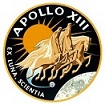
Day 6, part 7: Farewell, Aquarius
Corrected Transcript and Commentary Copyright ©2020 by W. David Woods, Johannes Kemppanen, Alexander Turhanov and Lennox J. Waugh. All rights reserved.
Last updated 2020-04-21
140:52:07 Lovell: I have an RCS light, Houston. [Pause.]
140:52:16 Kerwin: Okay, Jim. That's the one we warned you about some time ago. Low helium; no sweat.
140:52:22 Lovell: Oh, okay. [Long pause.]
140:52:39 Swigert: Okay, Houston. There's a star angle difference with stars 36 and 40.
140:52:46 Kerwin: How about that, baby!
140:52:49 Lovell: And I'm maneuvering, Houston.
140:52:50 Swigert: Okay - [garble].
140:52:52 Kerwin: Roger that. Copy you're maneuvering to the LM Jett attitude. Is that right?
140:52:58 Swigert: That's affirm...
140:52:59 Lovell: That's affirm.
140:53:00 Swigert: I'm going to torque those gimbal angles.
140:53:05 Kerwin: Torque them, babe, full stroke gimbal.
140:53:07 Swigert: There it is. Okay. I'll do a star check.
140:53:10 Kerwin: Okay. [Long pause.]
140:53:12 Swigert:[Garble] one fifty-three zero... [Garble]
140:53:27 Kerwin: Okay, Odyssey. You're suddenly ahead of the timeline. [Long pause.]
140:53:53 Kerwin: Odyssey, Houston. Request Omni Bravo. [Pause.]
140:54:06 Swigert: I am Omni Bravo, Joe.
140:54:08 Kerwin: Okay. [Pause.]
140:54:18 Swigert: Okay, Houston. The sextant star check passes. [Pause.]
140:54:25 Kerwin: Say again, Jack.
140:54:28 Swigert: I did a star check, and it passes. It puts that star right in the telescope.
140:54:35 Kerwin: Good enough. You can press on in the checklist, Jack. [Long pause.]
140:54:56 Kerwin: Mind out LM gimbal lock, Jim.
140:54:59 Lovell: It's the Command Module's gimbal lock I'm worried about.
140:55:03 Kerwin: [Laughter.] Okay. [Long pause.]
Apollo Control, Houston; 140 hours, 55 minutes into the flight. That star check report confirms proper alignment of the Command Module platform. We are 45 minutes away now from scheduled time of LM jettison.
140:55:28 Kerwin: Aquarius, Houston.
140:55:30 Lovell: Go ahead.
140:55:31 Kerwin: Roger. If you concur, we would be inclined to recommend that you go to AGS for the maneuver because you'll have to be there later on anyway.
140:55:43 Kerwin: And AGS Pulse is the recommendation.
140:55:46 Lovell: We're having trouble maneuvering, Joe, without getting it in gimbal lock.
140:55:50 Kerwin: Okay. You can ...
140:55:51 Lovell: You picked a lousy attitude, though, to separate.
140:55:55 Kerwin: Well, we apologize. Just take your time. Jim, we've got time now,
140:56:01 Lovell: Okay. [Long pause.]
140:56:28 Lovell: Aah, Houston, why can't I stay in PGNS Att Hold for the LM attitude hold?
140:56:38 Kerwin: Stand by on that, Jim. [Long pause.]
140:57:34 Kerwin: Aquarius, Houston. Over.
140:57:36 Lovell: Go ahead.
140:57:38 Kerwin: Okay. Our recommendation is that you stay in AGS for the LM Jett simply because we've thought it through. We've got the right deadbands and all set up. Over.
140:57:49 Lovell: Okay. It's a lot easier for me to maneuver in PGNS, Joe, than it is AGS.
140:57:56 Kerwin: Yes. You can maneuver in PGNS, Jim. I'm sorry, I thought you were talking about the Att Hold and the LM Jett afterward. You can maneuver in PGNS if you want to. [Long pause.]
Apollo Control; 140 hours, 58 minutes. Apollo 13 now 15,786 nautical miles away. Velocity now reading 15,192 feet per second.
140:58:22 Lovell: I want to get way over here, Joe. To prevent him into gimbal lock, I have the yaw at about - I'd say about almost 50 degrees.
140:58:35 Kerwin: Roger that. Just stay out of gimbal lock and that 45-degree isn't critical - the out of plane, that is. [Long pause.]
140:59:05 Kerwin: Odyssey, Houston. Request Omni Charlie.
140:59:10 Swigert: Okay. Going Omni Charlie.
140:59:11 Kerwin: Thank you.
140:59:12 Swigert: There.
140:59:13 Kerwin: Okay. Good.
141:00:20 Kerwin: Roger. That's Verb 46. Roger. Aquarius, Houston. [Pause.]
141:00:31 Lovell: Go ahead.
141:00:32 Kerwin: Okay, Jim. The particular DAP configuration we have set up now is using more fuel than we'd like out of system B. We'd like you to reconfigure the DAP to 30021. Over. [Pause.]
141:00:57 Kerwin: Thank you. [Long pause.]
141:01:35 Kerwin: Odyssey, Houston.
141:01:36 Swigert: Go ahead.
141:01:39 Kerwin: We'd like to have you turn the optics power off until you need them again, and we would like to have you check the RCS ring 1 and 2 temps for us. Over.
141:01:52 Swigert: Optics power going off.
141:01:54 Kerwin: Okay. [Pause.]
141:02:05 Haise: Okay, Joe. Our ring 1 is 50; ring 2 is plus 42.
141:02:09 Kerwin: Ring 1 is 50; copy. What was the other?
141:02:15 Kerwin: Got it. Thank you.
141:02:22 Lovell: Okay, Houston; Aquarius. I am at the LM Sep attitude and I'm planning on bailing out.
141:02:32 Kerwin: Okay. I can't think of a better idea, Jim.
141:02:36 Lovell: I'll go to AGS Att Hold, if you want me to.
141:02:40 Kerwin: We recommend that, Jim. [Long pause.]
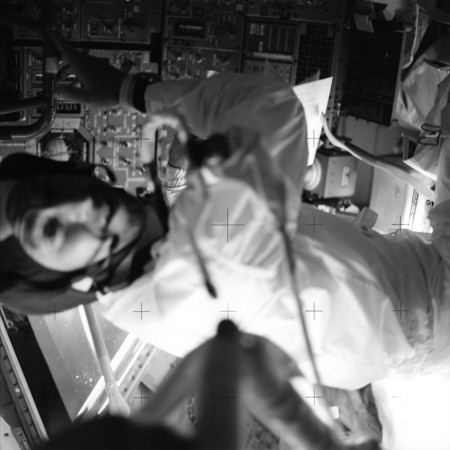
AS13-59-8484. Jim in the Lunar Module. What it would have looked like in Aquarius during these final moments of its occupancy.
141:02:54 Kerwin: Okay, Aquarius; Houston. In AGS Att Hold, we recommend Wide Dead Band. Over. [Pause.]
141:03:01 Lovell: I'm in the AGS Dead Band.
141:03:04 Kerwin: Roger. [Long pause.]
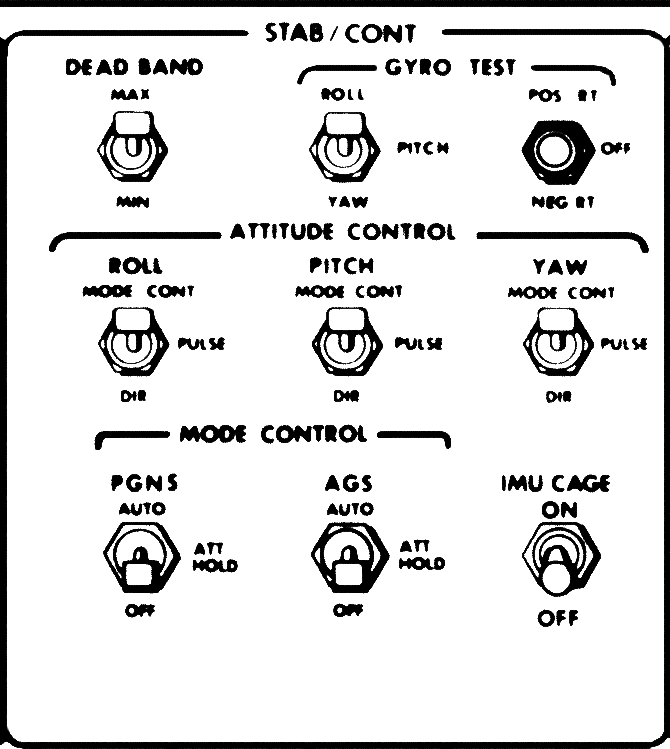
LM Attitude Control switches. Jim sets up AGS Attitude Hold with a wide deadband as one of his last acts in the LM. Scan via heroicrelics.org
141:03:35 Kerwin: Aquarius, Houston. Don't forget the [Garble] [Long pause.]
141:03:53 Haise: You need to relay something downstairs, Jim? [Pause.]
141:04:00 Kerwin: Odyssey, Houston.
141:04:03 Swigert: Go ahead, Joe.
141:04:04 Kerwin: Okay. Our troops would like to have you go to the Systems Test Meter and read out the injector temps on RCS for us. [Pause.]
141:04:12 Swigert: Okay. Okay. In work. [Long pause.]
141:04:49 Swigert: Okay, Houston. Let me read out the injector temperatures for you.
141:04:53 Kerwin: Go ahead.
141:04:57 Swigert: 5 Charlie, 4.2; 5 Dogs 4.6; 6 Alpha, 4.3; 6 Bravo, 4.3; 6 Charlie, 3.6; 6 Dog, 3.6.
141:05:19 Kerwin: Okay. Copy that. No complaints. [Long pause.]
141:05:32 Swigert: Okay. We're ready to proceed with hatch closeup.
141:05:35 Kerwin: Okay. Did Jim get the film out of Aquarius? [Pause.]
141:05:43 Swigert: Yes. We - You mean the film we took this morning?
141:05:46 Kerwin: That's affirm.
141:05:48 Swigert: Yes, We've transferred that.
141:05:50 Kerwin: Okay. Good deal. Jack, let me mention something about the hatch integrity check. You're going to vent the tunnel until you get a 3-psi Delta-P. That should take 9 or 10 minutes, and it's our firm feeling that you don't have to wait another 10 minutes after that for a leak check. If it holds pressure for a minute or so or even gets down there, you know you've got a good hatch. Over.
141:06:16 Swigert: Okay. Copy that.
Apollo Control, Houston; 141 hours, 8 minutes now into the flight. Apollo 13 presently 14,468 nautical miles out from Earth. All three crewmen now in the Command Module preparing to install the hatch. We show 32 minutes, 40 seconds away from scheduled time of Lunar Module jettison. This is Apollo Control, Houston.
This is Apollo Control, Houston; now 141 hours, 11 minutes now into the mission. It's less than 30 minutes away from the scheduled time of jettisoning the Lunar Module. We show Apollo 13 at an altitude of 14,020 nautical miles. We have an estimate of an altitude of 9,729 nautical miles at the time of jettisoning the Lunar Module. We're at 141 hours, 11 minutes; continuing to monitor. This is Apollo Control, Houston.
141:12:42 Swigert: Okay, Houston. We've got an O
2 Flow High.
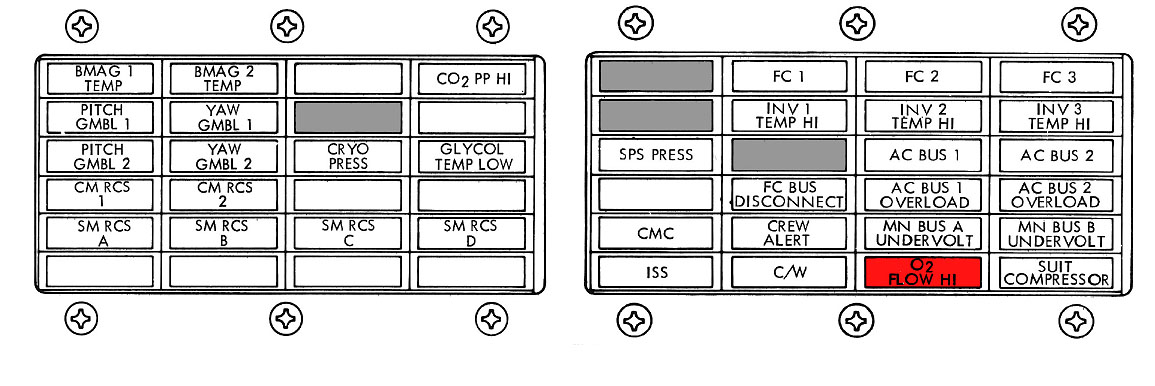
The O2 Flow High warning indicator.
141:12:47 Kerwin: Okay, Jack, are you...
141:12:53 Swigert: Well, we might be pressurizing a lot of the system that was not pressurized.
141:12:59 Kerwin: Roger. I expect that's the case. Let us check it.
141:13:04 Swigert: Okay. Take a good look at Cabin.
141:13:07 Kerwin: Will do. [Long pause.]
141:13:28 Kerwin: Odyssey, Houston. Just verify your Direct O
2 is Off. Over.
141:13:37 Swigert: Yes, sir. That is verified.
141:13:38 Kerwin: Okay, and...
141:13:39 Lovell: [Garble] it's dropping now, Joe.
141:13:43 Kerwin: Roger. We think that you were just pressurizing the cabin up to that regulator's particular spec.
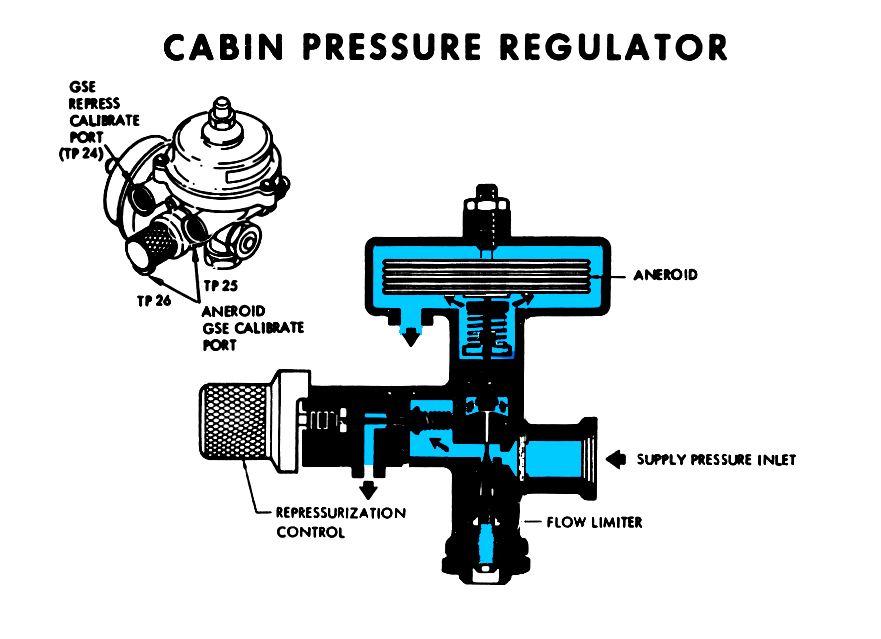
Joe's suggestion is that the regulator is simply allowing slightly more oxygen into the cabin than expected, and is not a cause of real worry.
141:15:14 Kerwin: Odyssey, Houston.
141:15:17 Swigert: Go ahead.
141:15:18 Lovell: Go ahead.
141:15:19 Kerwin: Okay. We're observing middle gimbal angle getting a little bit high. The LM appears to be deadbanding okay within its attitude, but just wanted you to know that we're keeping an eye on it and if it does get too high, we might want you to punch off early.
141:15:36 Kerwin: And verify that the hatch is secured and that you are venting the tunnel. Over.
141:15:42 Swigert: That's verified. We have a Delta-P of 2.8.
141:15:46 Kerwin: Real good. Real good. [Long pause.]
This is Apollo Control, Houston at 141 hours, 16 minutes into the flight. Apollo 13 now 13,283 nautical miles away from Earth with a velocity building up now to 16,350 feet per second.
141:16:27 Swigert: Okay, Joe. Since we're ahead of the time line, can I proceed on and kind of punch off early, or do you want me to punch off at exactly 1 hour?
141:16:35 Kerwin: Jack, when you are comfortably ready to punch off, you can go ahead and do it.
That was Jack Swigert receiving that confirmation from the ground from Joe Kerwin that he can jettison the Lunar Module at his convenience. So we'll stand by for that possibility at any time. We're at 141 hours, 17 minutes into the flight of Apollo 13.
141:17:49 Kerwin: Odyssey, Houston. We just had a formal Go for LM Jett at your convenience. Over.
141:17:57 Swigert: Okay. Thanks, Joe.
141:17:58 Kerwin: Okay. [Long pause.]
141:18:25 Kerwin: Okay, Odyssey; Houston. We're ready for you to bring the BMAGs On and Warm Up and all other things being equal, we'd like you to go through the LM Jett at - on the checklist you've got. And that is BMAGs 1...
141:18:38 Swigert: Okay. Will do.
141:18:40 Kerwin: ...1. That's BMAG 1 now, as you know.
141:18:45 Swigert: Yes, BMAG 1 is in Warm Up.
141:18:47 Kerwin: Good deal.
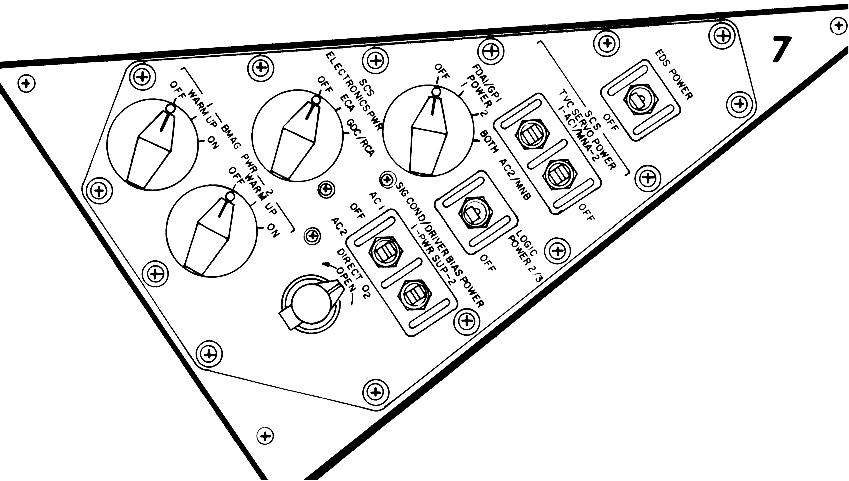
BMAG controls at Panel 7. They are powering up the BMAGs to provide a backup attitude reference in case the IMU fails. Scan via heroicrelics.org
Apollo Control, Houston; 141 hours, 20 minutes now into the flight. While we're standing by, we'll pass along some updated numbers from the Retrofire Officer. We show time of entry in the Earth's atmosphere at 142 hours, 40 minutes, 39 seconds. Blackout begins at plus 18 seconds from time of Entry Interface...
141:20:17 Swigert: Okay, Houston. Do you have a Command Module weight for me?
141:20:24 Kerwin: Stand by 1, Jack. [Long pause.]
Blackout ends at 3 minutes, 23 seconds from time of Entry Interface.
141:20:43 Kerwin: Odyssey, Houston.
141:20:47 Swigert: Go ahead.
141:20:48 Kerwin: Okay. I'm reminded that the entry DAP is all you've got. It'll initialize itself, and you won't have an - you won't have an RCS DAP, so you don't have to fool with it.
Drogue deploys at 8 minutes, 16 seconds. Main chutes deploy at 9 minutes, 4 seconds from time of Entry Interface. Predicted time of splash; 14 minutes, 1 second from time of Entry Interface. Standing by, continuing to monitor; this is Apollo Control, Houston.
Apollo Control, Houston; now 141 hours, 22 minutes into the flight. We show Apollo 13 presently at an altitude of 12,474 nautical miles, at a speed of 16,761 feet per second.
141:22:12 Swigert: Okay, Joe. I'm - Have you got your checklist out there on the SCS powerup?
141:22:17 Kerwin: That's affirm.
141:22:19 Swigert: Okay. I'm coming down here to a step that says FDAI Power, off. Is that what you want right now, I guess, huh?
141:22:28 Kerwin: Go ahead.
141:22:29 Mattingly: Okay, Jack. That FDAI Power, Off, is to stop momentary glitches as you bring up the BMAG to put it on, and you turn right around and put the FDAI Power right back on 1.
141:22:44 Swigert: Okay. And I don't have the BMAG Temp light out yet. Do you want me to go ahead and put the BMAG On with the Temp light still On?
141:22:50 Mattingly: That's affirm. We can go ahead and you'll have a good stable rate.
141:22:55 Swigert: All right. Let's do it.

BMAG 1 Temp caution light illuminated. They decide to press on either way.
Apollo Control, Houston; 141 hours, 24 minutes now into the flight. The flight surgeon's now monitoring the consoles are taking readings on Jack Swigert and Fred Haise's heart rates on these gentlemen just running over 100, slightly higher than average indicating an increased work load. We now show Apollo 13 at 12,064 nautical miles away from Earth, speed continuing to build up, now reading 16,989 feet per second. This is Apollo Control, Houston.
141:26:38 Swigert: Okay, Houston. We'll punch off at 141 plus 30.
141:26:43 Kerwin: Okay, Jack. We copy and we concur.
That was Jack Swigert indicating that they plan to jettison the Lunar Module in about 3 minutes from this time.
Apollo Control, Houston; 141 hours, 28 minutes into the flight. Apollo 13 now 11,590 nautical miles away from Earth. For reentry, the 3 crewmen will be traveling in shirt sleeve environment, not in their space suits. We're standing by now for reports of jettison of the Lunar Module. At 141 hours, 28 minutes; this is Apollo Control, Houston.
141:28:21 Swigert: Okay, Houston. Do we have a Go for Pyro Arm? [Long pause.]
141:28:34 Kerwin: Odyssey, Houston. We can give you a Go if you'll put the Logic On momentarily first.
141:28:41 Swigert: Okay. The SECS Logic is on.
141:28:42 Kerwin: Okay. Just copied that, and you are Go for Pyro Arm.
141:28:47 Swigert: Real fine.
141:29:51 Swigert: 10 seconds.
141:29:56 Lovell: Five. LM jettison.
141:30:05 Kerwin: Okay, copy that. Farewell, Aquarius, and we thank you. [Long pause.]
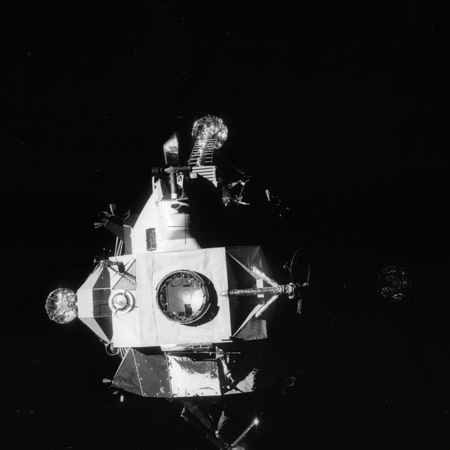
AS13-59-8564 - As Aquarius drifts away, a sequence of photographs from the CM window captures the crew's final glimpse of their lifeboat. This is the clearest of these images. As indicated by the crosses easily visible against the bright LM skin, the Reseau plate-equipped Hasselblad with a 80mm lens was used for these final photos. Notice the separated docking ring visible, having been pyrotechnically severed from the Command Module.
141:30:21 Kerwin: Watch gimbal lock there, Jack.
141:30:24 Swigert: Yeah, we did.
This is Apollo Control, Houston at 141 hours, 31 minutes into the flight. We have had Lunar Module jettison, and for Apollo 13, the age of Aquarius ended at 141 hours, 30 minutes Ground Elapsed Time.
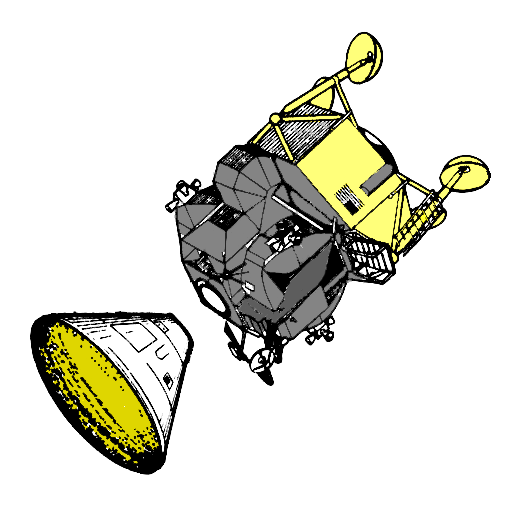
Diagram of the Lunar Module separation.
141:31:52 Kerwin: Odyssey, Houston. Request Omni Bravo.



